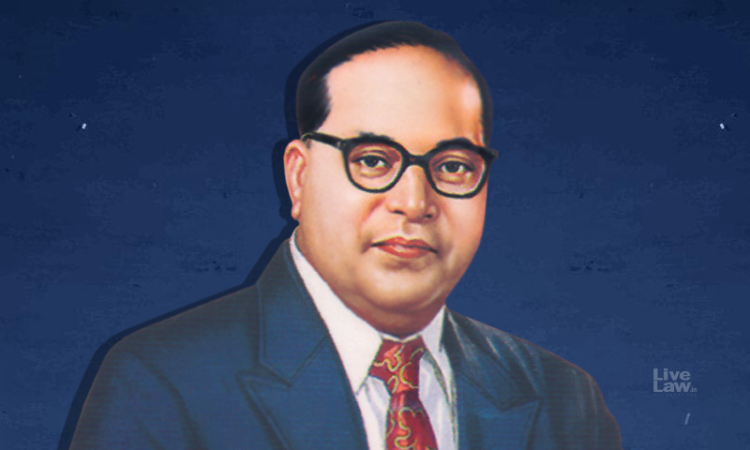Economic Justice And Dr. Ambedkar
Dr. Vikram Karuna
21 April 2025 11:11 AM IST

As India navigates the complexities of its economic landscape in 2025, the vision of Dr. B.R. Ambedkar, the architect of the Indian Constitution, remains a beacon for achieving economic justice. While Ambedkar's contributions to social justice and political equality are widely celebrated, his ideas on economic justice—deeply embedded in the Constitution—remain relatively unexplored. This article delves into the untouched dimensions of Ambedkar's economic thought, as reflected in the Constitution, and their relevance to contemporary India.
Ambedkar's Conception of Economic Justice
Dr. Ambedkar viewed economic justice as inseparable from social and political justice. He believed that without addressing economic inequalities, the promises of liberty and equality enshrined in the Constitution would remain hollow. In his seminal work, States and Minorities (1947), Ambedkar proposed a model of “state socialism,” advocating for state control over key industries to ensure equitable distribution of resources. He argued, “The State shall be responsible for ensuring that no citizen is denied the means of livelihood” (Ambedkar, 1947, p. 408).
This vision found expression in the Constitution, particularly in the Directive Principles of State Policy (DPSPs). Articles 38 and 39 encapsulate Ambedkar's economic philosophy, urging the state to minimize inequalities in income, status, and opportunities, and to ensure that the ownership and control of material resources are distributed to serve the common good. Unlike the Fundamental Rights, which are enforceable, the DPSPs are non-justiciable, often relegating Ambedkar's economic ideals to aspirational goals rather than actionable mandates.
The Constitutional Framework
Ambedkar's role as the chairman of the Drafting Committee allowed him to infuse the Constitution with principles aimed at economic justice. Article 39(b) and (c) specifically call for preventing the concentration of wealth and ensuring that the economic system does not result in the exploitation of the disadvantaged. These provisions were revolutionary for their time, reflecting Ambedkar's foresight in addressing the perils of unchecked capitalism in a deeply unequal society.
However, the non-binding nature of the DPSPs has limited their implementation. Scholars like Granville Austin note that Ambedkar saw the DPSPs as “instruments of instruction” to guide future governments (Austin, 1966, p. 75). Yet, successive governments have often prioritized economic growth over equitable distribution, sidelining Ambedkar's vision. For instance, the liberalization policies of the 1990s, while spurring growth, exacerbated income disparities, contradicting the spirit of Article 39.
Unexplored Dimensions
One of the least discussed aspects of Ambedkar's economic thought is his emphasis on land reforms and cooperative farming. In his writings, he argued that landlessness was a primary source of economic oppression for Dalits and marginalized communities. He envisioned a system where land would be redistributed to ensure access for the landless, coupled with state-supported cooperative agriculture to enhance productivity (Ambedkar, 1947, p. 420). This idea, though reflected in Article 39's call for equitable resource distribution, remains largely unimplemented.
Another unexplored facet is Ambedkar's advocacy for full employment as a constitutional obligation. In the Constituent Assembly debates, he emphasized that economic security—through guaranteed employment—was essential for true democracy (Constituent Assembly Debates, Vol. VII, 1948). While Article 41 of the Constitution urges the state to secure the right to work, this provision has not been fully realized, even as schemes like the Mahatma Gandhi National Rural Employment Guarantee Act (MGNREGA) attempt to address unemployment partially.
Relevance in Contemporary India
In 2025, India stands at a crossroads. The Gini coefficient, a measure of income inequality, has risen to alarming levels, with the top 1% owning over 40% of the nation's wealth (Oxfam India, 2024). Rural distress, unemployment, and caste-based economic disparities persist, underscoring the urgency of revisiting Ambedkar's ideas. His call for state intervention to curb wealth concentration resonates in debates over wealth taxes and universal basic income.
Moreover, Ambedkar's vision of economic justice aligns with global movements for inclusive development. The United Nations' Sustainable Development Goals (SDGs), particularly Goal 10 (Reduced Inequalities), echo his emphasis on equitable resource distribution. Implementing Ambedkar's ideas could position India as a leader in achieving economic justice on the global stage.
Challenges and the Way Forward
The primary challenge to realizing Ambedkar's vision lies in the political economy. Vested interests, bureaucratic inertia, and the prioritization of corporate-led growth have diluted the DPSPs' transformative potential. Additionally, the judiciary's reluctance to enforce DPSPs, citing their non-justiciable nature, has limited their impact. Legal scholar Upendra Baxi argues that the judiciary must adopt a more activist stance to interpret DPSPs as integral to Fundamental Rights (Baxi, 2008, p. 112).
To operationalize Ambedkar's vision, India must prioritize policies that address structural inequalities. Strengthening land reform laws, expanding employment guarantee schemes, and introducing progressive taxation are steps in this direction. Civil society and academia must also play a role in reviving discourse on Ambedkar's economic thought, ensuring it is not confined to social justice alone.
Dr. B.R. Ambedkar's vision of economic justice, woven into the Constitution, remains a powerful yet underexplored framework for addressing India's inequalities. As the nation grapples with economic challenges, his ideas offer a roadmap for building a just and inclusive society. By embracing the spirit of Articles 38 and 39, India can honor Ambedkar's legacy and fulfill the Constitution's promise of economic justice for all.
References:
· Ambedkar, B.R. (1947). States and Minorities. Bombay: Thacker & Co.
· Austin, G. (1966). The Indian Constitution: Cornerstone of a Nation. Oxford: Clarendon Press.
· Baxi, U. (2008). The Future of Human Rights. New Delhi: Oxford University Press.
· Constituent Assembly Debates, Vol. VII (1948). New Delhi: Lok Sabha Secretariat.
· Oxfam India (2024). Inequality Inc.: How India's Wealth Divide Grows. New Delhi: Oxfam India.
Dr. Vikram Karuna is an Assistant Professor, School of Law, Justice & Governance, Gautam Buddha University, Greater Noida. Views are personal.


